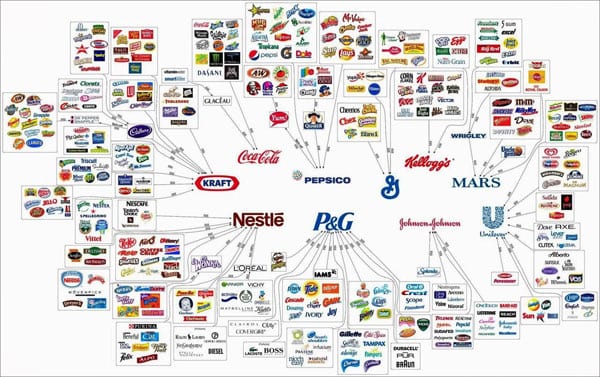
November 25, 2018; New York Times
The Open Markets Institute, an advocacy nonprofit that supports anti-trust regulation, released data that show, “Big companies are much more dominant than they were even 15 years ago,” reports David Leonhardt in the New York Times. This data matches with employment data that Leonhardt reviewed in June, which shows that large firms are employing a growing share of the US workforce.
| 1989 | 2014 | |
| Fewer than 20 workers | 21% | 18% |
| 20 to 49 | 11% | 10% |
| 50 to 99 | 7% | 8% |
| 100 to 999 | 8% | 9% |
| 1,000 to 9,999 | 18% | 19% |
| 10,000 workers and up | 24% | 28% |
As Leonhardt pointed out at the time, “The share of Americans working for small companies fell to 27.4 percent in 2014, the most recent year for which data exists, down from 32.4 [percent] in 1989….Today, companies with at least 10,000 workers employ more people than companies with fewer than 50 workers.” By contrast, 25 years before, a worker was a third more likely to work at a firm with less than 50 workers than at a firm with 10,000 workers.
The rise of corporate consolidation is even more dramatic than employment, however. In more than half of the 26 industries that the Open Markets Institute analyzed, two firms now control over half the market. Moreover, many industries show gains in concentration of the top two firms of over 20 percentage points, including hardware stores, shipbuilding, private prisons, pharmacies, tobacco, mattress manufacturing, and craft stores.
Top-Two Market Share
Industries with increasing corporate concentration
| Early 2000s | 2018 | |
| Hardware stores | 42% | 81% |
| Shipbuilding | 24% | 61% |
| Private prisons | 19% | 56% |
| Tobacco | 52% | 83% |
| Pharmacies | 30% | 61% |
| Mattress manufacturing | 36% | 61% |
| Craft stores | 39% | 59% |
| Airlines | 23% | 41% |
| Car rental | 26% | 41% |
| Industrial laundry | 24% | 39% |
| Meat processing | 12% | 25% |
| Credit rating | 13% | 25% |
| Sanitary paper | 54% | 64% |
| Truck and bus mfg. | 53% | 63% |
| Railroads | 48% | 57% |
| Amusement parks | 60% | 70% |
| Credit cards | 17% | 25% |
| Movie theaters | 26% | 31% |
Industries with declining concentration
Sign up for our free newsletters
Subscribe to NPQ's newsletters to have our top stories delivered directly to your inbox.
By signing up, you agree to our privacy policy and terms of use, and to receive messages from NPQ and our partners.
| Early 2000s | 2018 | |
| Aircraft manufacturing | 41% | 40% |
| Pesticides | 39% | 36% |
| Outdoor ads | 27% | 24% |
| Investment banking | 24% | 14% |
| Tire manufacturing | 70% | 46% |
New tech-based industries
| 2012 | 2018 | |
| Smartphones | 79% | 99% |
| Social networks | 76% | 82% |
| Cellphone service | 66% | 69% |
Drivers of corporate consolidation, notes Leonhardt, include both mergers and network effects. Social media is prone to network effects; for instance, the value of a platform like Facebook rises for each individual user as the number of Facebook users increases. Leonhardt contends that while corporate concentration has benefitted shareholders, it has been “bad for almost everyone else. Sooner or later, the companies tend to raise prices. They hold down wages, because where else are workers going to go? They use their resources to sway government policy.”
Leonhardt is not alone in this view. Two years ago, an academic paper by Gustavo Grullon (Rice University), Yelena Larkin (York University), and Roni Michaely (Cornell) found increasing corporate concentration in over 75 percent of examined industries. The authors summarized their findings by noting, “Overall, our evidence indicates that the trend of increased competition across US industries has reversed in the past two decades. Markets have become more concentrated, and profit margins have increased proportionally to the increase in industry concentration. Further, the increased profit margins are mainly driven by higher operating margins, rather than increases in operational efficiency, perhaps due to greater market power.”
Even the Economist has taken notice, pointing out that concentrated market power slants politics. A July article notes that, “Research in political science gives substance to the impression that America’s rich wield outsize influence.…fewer than 30,000 people account for a quarter of all national political donations from individuals and for more than 80 percent of the money raised by political parties.”
Moreover, the Economist observes that, “The rich have many [non-electoral] means to shape public opinion: financing nominally apolitical think-tanks, for instance, or buying media outlets. Although their power may sometimes be used to influence the result of a particular vote, it is often deployed more subtly, to shape public narratives about which problems deserve attention.”
In terms of policy solutions, one that both Leonhardt and the Open Markets Institute advocate is a rebirth of anti-trust enforcement. “Eventually, the government will probably need to break up existing giants,” writes Leonhardt, “as it did to the old AT&T and Standard Oil. One obvious candidate is Facebook, which has gobbled up Instagram, WhatsApp, and other businesses.”—Steve Dubb











